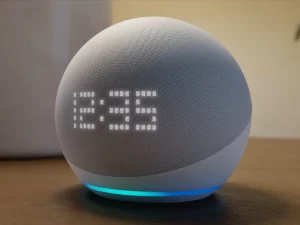Introduction: Inside Amazon’s Strategy
In the realm of smart home technology, Amazon has emerged as a major player, driving innovation and setting new standards for interconnected living spaces. With their robust ecosystem of Alexa-enabled devices and a relentless pursuit of user-centric advancements, Amazon is not merely keeping up with the times; they are actively shaping the future of smart homes. This article delves into Amazon’s strategy and vision for the future of smart home technology.
Voice Control: The Cornerstone of Amazon’s Ecosystem
Amazon’s journey into the world of smart homes began with the introduction of Alexa, their voice-controlled virtual assistant. This innovation revolutionized the way we interact with our smart devices. However, Amazon did not stop at basic voice commands. Their focus has always been on making voice interactions more intuitive and natural.
To achieve this, Amazon has developed a sophisticated large language model (LLM) capable of understanding the nuances of each user’s specific home setup. This means that instead of rigidly structured commands, users can engage with Alexa in a more conversational manner. Simply saying, “Alexa, I’m cold,” prompts Alexa to adjust the temperature without the need for specific device names or commands. Amazon’s commitment to intuitive voice control is a fundamental pillar of their strategy.
Interoperability: Embracing Device Diversity
In the diverse landscape of smart home devices, compatibility and interoperability are critical. Users often have devices from various manufacturers, each with its own ecosystem. Amazon recognizes the importance of seamless integration and has actively embraced open standards.
One notable initiative is Amazon’s support for Matter, a smart home standard designed to promote interoperability among devices from different brands. This ensures that users can connect and control devices from various manufacturers within a unified ecosystem. Amazon’s commitment to interoperability simplifies the user experience and empowers users to build a truly customized smart home.

Proactive Automation: Technology That Anticipates Your Needs
Imagine a smart home that understands your needs without you having to issue explicit commands. Amazon envisions this future and is actively working to make it a reality. Currently, 40% of smart home actions are initiated by Alexa without any user prompts. This statistic highlights Amazon’s progress in creating a proactive smart home ecosystem.
To enhance this aspect, Amazon is developing technologies that allow devices to proactively respond to environmental cues. For example, with compatible sensors, Alexa can detect room brightness and occupancy. This means that you no longer need to manually control lights when entering a room; the lights will adjust automatically based on your presence and preferences. Amazon’s vision of proactive automation promises to make smart homes not just responsive but anticipatory.
Simplified Device Management: The Role of Echo Hub
As the number of connected devices in smart homes continues to grow, managing them becomes increasingly complex. Amazon addresses this challenge with the introduction of Echo Hub. Echo Hub is an Alexa-enabled smart home control panel designed to simplify device management.
Featuring an 8-inch customizable touchscreen, Echo Hub provides users with an intuitive interface to group, manage, and monitor their smart devices. Users can initiate routines, access live camera feeds, and control their entire smart home ecosystem from a central hub. Echo Hub supports multiple smart home protocols, ensuring compatibility with a wide range of devices. It represents Amazon’s commitment to providing users with streamlined control over their interconnected devices.
Table: Key Elements of Amazon’s Smart Home Strategy
| Element | Description |
|---|---|
| Voice Control | Amazon’s large language model enables more intuitive voice interactions, making smart homes easier to control with natural language. |
| Interoperability | Support for open standards, such as Matter, ensures that devices from different manufacturers can seamlessly integrate into Amazon’s smart home ecosystem. |
| Proactive Automation | Amazon is developing technology that allows devices to anticipate user needs and respond proactively to environmental cues. |
| Simplified Management | Echo Hub serves as a central control panel, offering an intuitive interface for managing and monitoring a growing number of interconnected devices. |
Conclusion
Amazon’s strategy for shaping the future of smart home technology revolves around enhancing voice control, promoting interoperability, enabling proactive automation, and simplifying device management. Their vision is to create an ecosystem where technology seamlessly integrates into daily life, making smart homes more intelligent, convenient, and user-centric. As Amazon continues to innovate, the future of smart homes looks promising, offering a harmonious blend of technology and everyday living.




